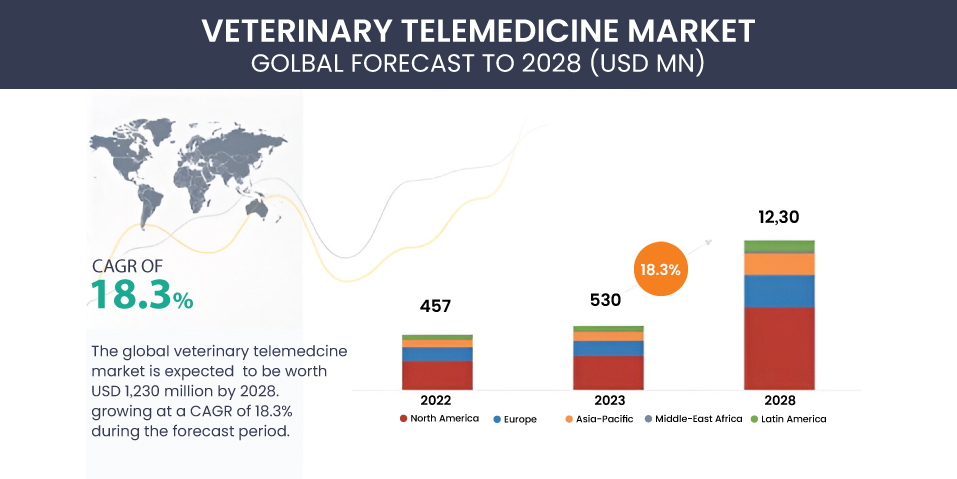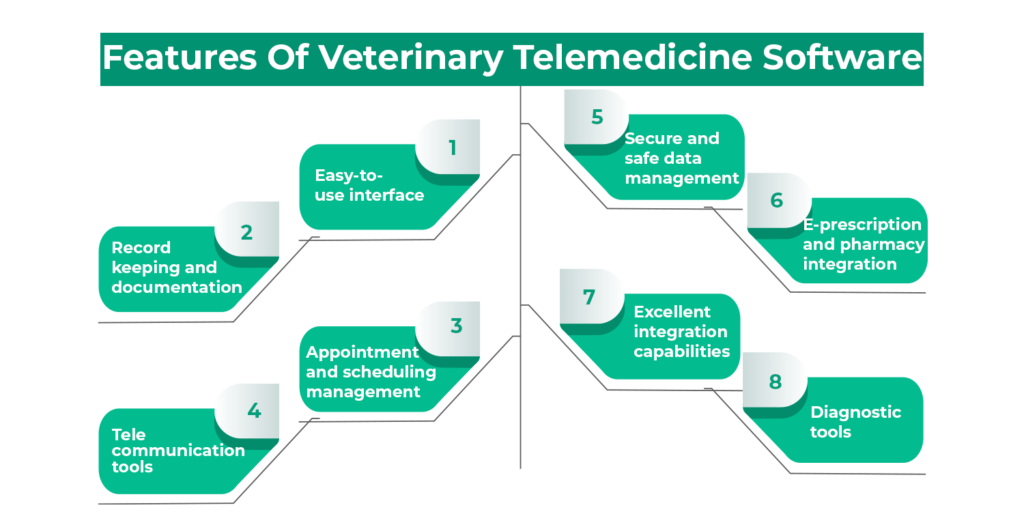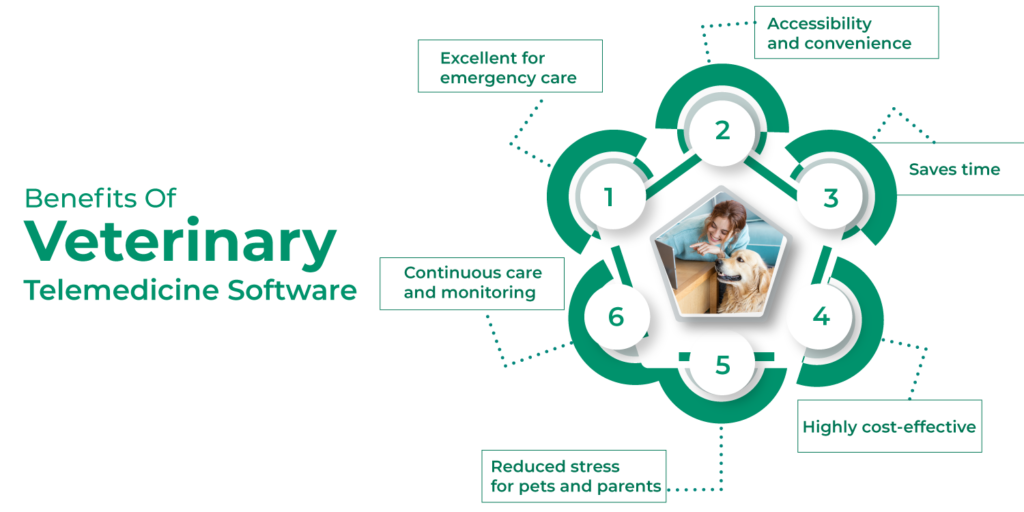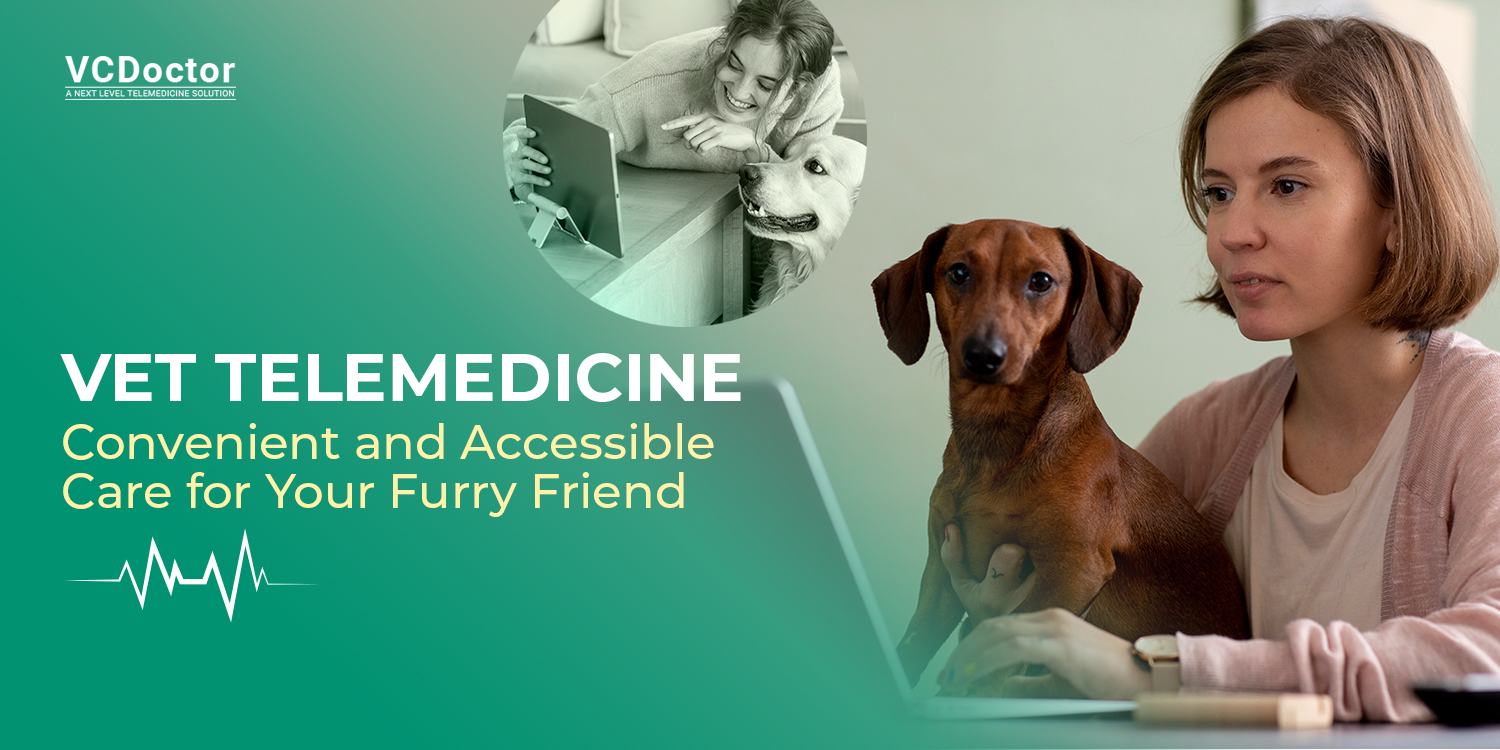Vet Telemedicine: Convenient and Accessible Care for Your Furry Friend
Today, we live in the post-COVID-19 and digitally advanced era where vet telemedicine software is bringing change to the animal healthcare industry. Although the use of telemedicine in the healthcare industry for humans is quite evident, online vet care through telemedicine software has also skyrocketed, especially after the sudden outburst of COVID-19. According to a report, the global veterinary telemedicine market is to grow at a CAGR of 18.3% and its overall market size will increase to $530 million in 2023. Additionally, Over 30% of US veterinary clinics use telemedicine technology to monitor, diagnose and treat animals.
In order to stay ahead, it’s high time to include telemedicine software in the animal healthcare industry, as it will save a lot of time, promise instant solutions, and save lives. If you want to dive deep into veterinary Telemedicine software to make it accessible for your furry friend, you’ve landed on the right page. This article is a complete guide on vet telemedicine, veterinary Telemedicine software, its benefits, challenges, and more. So, without any further ado, let’s dive in!

What Is Veterinary Telemedicine?
Veterinary telemedicine is the use of technology to offer veterinary medical services, which includes accessing a pet’s health based on their symptoms and remotely planning a personalized treatment. Vet telemedicine includes advice, treatment, diagnosis, care management, consultation, and more. Several latest innovations have been made to make the veterinary telemedicine industry more advanced.
Features Of Veterinary Telemedicine Software
Here are the top features of veterinary Telemedicine software:

1. Easy-to-use interface
A successful veterinary Telemedicine software has an easy-to-use or user-friendly interface that is easily accessible to all, ranging from professional experts to pet owners. It comes with an easy-to-understand interface, simple UX, an intuitive layout, an easy navigation system, and a detailed onboarding process for first-time users. Since users with different technological abilities will use this telemedicine platform, it must be easy to use so that it is widely accepted and adopted.
2. Excellent integration capabilities
Another must-have feature in your veterinary Telemedicine software is its ability to integrate electronic health record systems and existing veterinary Telemedicine management systems. This easy integration promises a seamless flow of data, ensures updated patient records, and reduces the need to enter information manually. Additionally, seamless integration with imaging equipment, laboratory systems, and multiple payment gateways improves overall efficiency.
3. Telecommunication tools
The most important and preferred feature without which telemedicine software cannot work is its telecommunication tools. Thus, telecommunication tools are called the heart and soul of the software. To conduct live interaction between pet owners and veterinarians, telecommunication tools are vital as they promote photo-sharing, conducting live calls, video calls, and messaging functionalities.
4. Diagnostic tools
In veterinary Telemedicine software, certain diagnostic tools are essential and must be incorporated. For example, the veterinary Telemedicine software must use an AI symptom checker to analyze the underlying condition, resulting in better pet’s diagnosis. The software must also include stethoscopes for quick lung and heart checkups.
5. Secure and safe data management
Since healthcare professionals and experts manage sensitive and confidential patient information, they need robust data security. This includes encryption standards, secure servers, and stringent access controls so your data remains protected and safe.
6. Appointment and scheduling management
For a seamless remote consultation on the telemedicine application, features such as online appointment scheduling, automated reminders, and calendar integration must be included, as these features minimize the functioning of pet owners and professional experts. Additionally, it streamlines the process faster and makes it hassle-free, making it more convenient for pet owners.
7. E-prescription and pharmacy integration
Coming up with an e-prescription or electronic prescription and seamlessly integrating it with all nearby pharmacies is an essential feature in veterinary Telemedicine software. Using this feature, your experts can suggest and prescribe medications as soon as possible, ensuring overall services are offered to pets.
8. Record keeping and documentation
Records and documents are essential in the healthcare industry. The veterinary telemedicine software must have record-keeping and documentation features so that it can easily manage the patients’ records, generate medical reports, make consultation transcriptions, and more.
Benefits Of Veterinary Telemedicine Software
Here are the top benefits of veterinary Telemedicine software:

1. Accessibility and convenience
Veterinary telemedicine software is highly convenient, especially for pet parents and pets living in less-developed areas without vet facilities. With a telemedicine application, you can connect with your pet’s doctor online from the comfort of your home while getting adequate treatment at your convenience. This makes the entire process highly accessible.
2. Reduced stress for pets and parents
While visiting the veterinary clinic, pets and their parents experience a lot of stress and discomfort. The presence of other animals, the continuous barking sound, the unfamiliar environment, and other factors can cause discomfort to the pet, making them anxious. Through the vet telemedicine software, there is no need to travel hours to your veterinary clinic to get the best-quality healthcare services at home. Since the stress levels are under control, the examination and diagnosis are accurate.
3. Highly cost-effective
Veterinary telemedicine software solutions are highly cost-effective for pet parents. You only have to pay the consultation fee, whereas additional costs like travel expenses, time, and more are saved, making this option highly affordable.
4. Saves time
Another major benefit of vet telemedicine software is that it saves a lot of time, as there is no need to spend extra time visiting a nearby veterinarian and getting your pet checked. You can conduct an online consultation, get in touch with an expert professional, and discuss your pet’s health without making additional efforts.
5. Continuous care and monitoring
Through the vet telemedicine software, the pet can receive continuous care and professional monitoring post-surgery or for a chronic condition. Through remote consultations, health experts closely analyze the recovery process, detect underlying symptoms, and plan a personalized treatment based on it. This ongoing support ensures the pet receives the best medical facilities without any trouble.
6. Excellent for emergency care
Conditions like accidents, heart attacks, and more can occur anywhere and anytime. In these conditions, taking the pet to a vet becomes a task that can take away their lives as well. To avoid these conditions, veterinary Telemedicine software comes in handy. Using this software, the pet parents can instantly get in touch with experts and get medical assistance. Additionally, if the emergency is too complex and requires in-person treatment, at least the pet owners can give initial first-aid until the pet is transported to a physical veterinarian.
Challenges Of Veterinary Telemedicine Software
There are certain challenges to veterinary telemedicine software. These include:
1. Understand the unique demands of the veterinary field
As you step into the veterinary Telemedicine software industry, understanding the unique and ever-evolving demands of the veterinary field becomes challenging. Since veterinary deals with a wide range of animals and species, each has unique medical needs, treatment methods, and diagnostic processes that need to be fulfilled. Your vet telemedicine software must be able to comprehend the unique needs and cater to a wide variety.
2. Ensuring privacy and data security
Another major challenge standing in front of the telemedicine industry is handling sensitive and confidential information. Since veterinary Telemedicine software will record all the details about the pet, the chances of data breaches always exist, leading to personal and legal consequences. To avoid these consequences, you must incorporate strong security measures like complex encryption methods, secure data transmission, and rigorous access control measures to protect all the data.
3. Creating interactive and user-friendly design
Veterinary Telemedicine software must be highly interactive and user-friendly so that anyone can use it without facing any complications. However, building an easy-to-use veterinary Telemedicine software becomes a task as it includes several features to cater to different aspects of veterinary telemedicine.
4. Integration with existing systems
Seamless integration of veterinary Telemedicine software with other existing systems is another major challenge, as it is important for your software to interact with other systems for smooth functioning. This integration minimizes any interruptions in the clinical workflow and maximizes work efficiency.
Services Offered Through Veterinary Telemedicine Software
Some major services offered through vet telemedicine software are remote consultation for pets and complete animal care. It helps animal health experts connect with pet owners, provides virtual advice, diagnoses diseases, detects symptoms, tracks recovery, and offers personalized treatment plans and recommendations. Some popular veterinary telemedicine services include AirVet, PetDesk, Dutch, Vetstoria, Pawp, PetsApp, Vetster, FirstVet, Wagr, Fuzzy, and others.
How Do You Prepare Before The Veterinary Telemedicine Consultation?
Here are some steps that a pet parent must follow before a vet telemedicine consultation:
1. Prepare your pet for the consultation so that they can sit calmly.
2. Collect all important documents and details about the pet
3. Jot down symptoms and other signs of the condition and explain it to the professional expert.
4. If you’re going for a video call, use a computer or a laptop with an excellent camera and audio facility
5. Get in touch with your present vet and see if they can also join the call for a second opinion.
6. Schedule another call in case the symptoms get worse.
Want to Build a Feature-rich Telemedicine Software?
Frequently Asked Questions
1. What is telemedicine software?
Telemedicine is a new-age technology that offers excellent and professional medical solutions and health facilities from a distance or remotely. Telemedicine software is designed and developed by experienced developers where live consultation is conducted, and symptoms and underlying conditions are discussed. Further, a comprehensive treatment plan is formulated to check the patient’s health. You will need smartphones, tablets, and laptops to have audio/visual capabilities to conduct consultations on telemedicine.
2. How is veterinary telehealth used?
Generally, vet professionals use vet telemedicine software to check the animal, conduct a diagnosis, and detect all symptoms. In some instances, telehealth is used for a second opinion or by people living in less developed areas without vet facilities. If you’re a pet owner whose pet has suffered an accident or needs emergency care, veterinary telehealth can help you through online consultation.
3. List the top most important features of a vet telemedicine application
Some of the most essential features of a bet telemedicine application or software are:
- Access to the doctor’s profile
- appointment management
- Profile page and Dashboard for the pet
- Electronic medical records and pet’s history
- remote pet’s monitoring or RPM module
- E-prescription
- Internal data exchange
- Video conferencing
- Symptom checker
4. What is the step-by-step process of veterinary Telemedicine software development?
Here is the step-by-step development process for vet telemedicine software:
- Understand the entire veterinary Telemedicine landscape and do market research rightfully.
- Based on your research findings, come up with a user-friendly design and idea addressing all major pain points.
- After designing and conceptualizing, choose prototyping and validation, wherein you will get a glimpse of the end product.
- Test your codes thoroughly for a bug-free system and ensure robust data security provisions.
- Once everything is in place, it’s time to launch the veterinary Telemedicine software. After making it live, offer complete post-launch support.
Wrapping Up
Ever since the world hit the COVID-19 pandemic, remote services have taken the front seat. Like most industries, the healthcare industry has also experienced a sudden change in the way the services are offered. Today, patients and doctors are relying on vet telemedicine services, making the best healthcare facilities accessible for your furry friend.
The best part is these services are available for people living in rural areas or someone in an emergency. Remember, developing a vet telemedicine software is a complicated process. Thus, you can hire experts from VCDoctor and professional solutions at affordable prices. We hope this article helped you to understand about vet telemedicine in detail.




